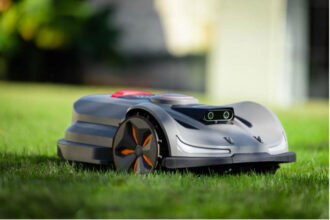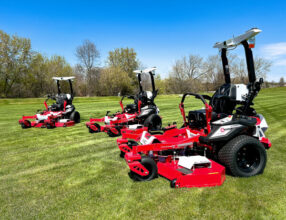Embrace the future of green spaces and landscaping technology
When you imagine the future of your landscaping business, what do you envision? A drone that delivers replacement parts from your equipment truck to landscapers on the job? Quiet, eco-friendly tools that keep your team working alongside homeowners and their neighbors? These technologies may seem distant now, but they’re the type of innovation that the parks of the future will demand.
As with the current state of most things in the United States, the future of the landscaping industry is uncertain — but it is surely green. Green spaces have always been more than just backyards and baseball fields. They’re places where communities gather, city dwellers unwind and tourists visit. That’s not likely to change anytime soon.
Take the Boston Common, for instance. Established in 1634, the Common bills itself as America’s oldest public park. Its grounds have seen the training exercises of revolutionary troops; the sermons of the Rev. Martin Luther King Jr.; and throngs of visitors, numbering in the hundreds of thousands each year. Whether it’s the Boston Common, Manhattan’s Central Park, Chicago’s Humboldt Park, or the local playground in your neighborhood, parks have been, and always will be, central to the way Americans live their daily lives.
Creating parks for the future
It’s the landscaping industry’s mission to maintain those parks, and to do so responsibly. In 2015, the United Nations challenged countries around the world to work toward a set of 17 sustainable development goals. Those goals include ending poverty and hunger, providing high-quality education, and building sustainable communities. The landscaping industry may not educate the world’s children, but we can do our part to make cities more sustainable.
Parks and sustainability go hand in hand. Lush, vibrant green spaces are the bedrock of sustainable cities, as they encourage residents to be more active and more in touch with the environment around them. To make cities sustainable, it makes sense to look to our public parks.
If the landscaping industry has anything to say about it, public parks will continue to fill urban cities with natural beauty. In a survey of more than 500 students around the world, Husqvarna found that the next generation of landscape architects largely expects parks to occupy substantially more urban space by 2030. Roughly nine out of 10 students believe that the purpose of future urban parks will be to have a positive impact on the surrounding cities, acting as the cities’ “lungs.” The consensus among landscape architecture students from Ohio State University to the University of Tokyo is that the future will hold more green spaces to landscape and more demand for sustainable elements.
Meeting consumer demand
In the United States, we have already seen a push for more sustainable landscaping services, as localities from coast to coast adopt legislation that limits the use of gas-powered outdoor power equipment. As early as 2005, the city of Palo Alto, Calif., banned the use of gas-powered leaf blowers in residential areas. More recently, in December 2016, a similar ban went into effect in the city of Sonoma, Calif. On the East Coast, bans have been enacted or considered in Greenwich, Conn.; Maplewood, N.J.; and Washington, D.C. — just to name a few. Meanwhile, an online petition to institute a comparable ban in Seattle had nearly 1,000 signatures in February.
In some cases, residents are demanding such bans because of the noise that gas-powered outdoor power equipment produces. The sound of a traditional lawn mower or leaf blower simply isn’t welcome in many residential neighborhoods anymore, whether it’s 9 a.m. on a Saturday or 1 p.m. on a Wednesday.
In other cases, ban supporters are seeking to rid their communities of the emissions released by such equipment. According to a study by the Environmental Protection Agency (EPA), gas-powered lawn and garden equipment can emit more than 6 million tons of carbon, nitrogen and similar substances per year. That’s far less than the sum total of annual emissions from the cars and trucks we drive every day, but it’s still a staggering number that helps to explain the landscaping bans that are sweeping the country.
Still, the EPA did note in its study that the emissions from gas-powered outdoor power equipment are likely to reduce in the years ahead as equipment becomes more eco friendly. In fact, no matter which way you look at the state of the landscaping industry, smarter, more sustainable technology seems to be the answer. New technologies can make landscaping teams more productive, lawn care quieter, and the air healthier.
Moreover, this technology can help landscapers meet consumer demand. In August 2016, Husqvarna surveyed U.S. consumers to gauge their investment in outdoor green spaces, and their preferences for how those green spaces are maintained. The findings overwhelmingly demonstrated that consumers not only value their green spaces, but that they’re also willing to pay more to ensure that those green spaces are maintained with the right tools.
According to the survey, nearly two-thirds — 65 percent — of consumers who have a lawn would choose a landscaper who uses eco-friendly outdoor power equipment over one who doesn’t. Meanwhile, more than half — 57 percent — of consumers would pay more for a landscaper who uses quieter outdoor power equipment. Most survey respondents reported visiting a public park once a week or more, and they largely believe that purchasing eco-friendly outdoor power equipment should result in tax benefits.
Taken together, these results, plus the bans that have begun to affect landscapers in many parts of the country, point to a must-do action item for any landscaping company that wants to remain competitive in the future of the industry: Embrace the next generation of landscaping technology.
Building a next-generation fleet
Battery-powered outdoor power equipment is part of that next generation. Battery-powered trimmers, leaf blowers and chain saws offer all the power of their gas-powered equivalents, but the output is quieter and less polluting.
 Productivity and performance are typically the most important benchmarks for outdoor power equipment, but they’re not the only areas where lawn and tree care professionals stand to benefit from using battery technology. With fewer moving parts, there’s less maintenance involved over the lifetime of the equipment. In Husqvarna’s case, battery-powered products are also significantly lighter than their gas-powered counterparts, making them more ergonomic for landscapers who work long days.
Productivity and performance are typically the most important benchmarks for outdoor power equipment, but they’re not the only areas where lawn and tree care professionals stand to benefit from using battery technology. With fewer moving parts, there’s less maintenance involved over the lifetime of the equipment. In Husqvarna’s case, battery-powered products are also significantly lighter than their gas-powered counterparts, making them more ergonomic for landscapers who work long days.
With this next generation of landscaping technology comes the opportunity to make tools — and the approach to landscaping — smarter. For example, a trimmer head should offer two-way rotation, so landscapers don’t have to walk backward while they work. A robotic lawn mower should run frequently to keep a lawn consistently trimmed, thereby reducing the need for irrigation and fertilizers. A fleet operator should be able to track equipment use and maintenance from a mobile app. And, yes, a drone should deliver replacement parts to landscapers on the job and in a pinch.
Gas-powered outdoor power equipment will have its place in the future of our industry, just as gas-powered vehicles still have their place on our roads. That said, landscaping companies are proving that emissions-free landscaping and robotic mowing can indeed lend themselves to a business model that’s both sustainable and profitable.*
Like the greenery we tend to, the landscaping industry must evolve. All around us, cities are growing, with technology and consumer demand driving much of that growth. Imagine what green spaces will be capable of when landscapers also harness next-generation technologies and a streak of sustainability.
 * For a profile of Kick Gas Lawn Care in Mississauga, Ontario, Canada, and how they are using battery-powered landscape equipment, visit https://www.youtube.com/watch?v=BUnghJFoWUM
* For a profile of Kick Gas Lawn Care in Mississauga, Ontario, Canada, and how they are using battery-powered landscape equipment, visit https://www.youtube.com/watch?v=BUnghJFoWUM
 Walt Rose is national sales manager for commercial lawn & garden and tree care at Husqvarna.
Walt Rose is national sales manager for commercial lawn & garden and tree care at Husqvarna.




